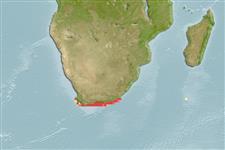Elasmobranchii (sharks and rays) >
Carcharhiniformes (Ground sharks) >
Scyliorhinidae (Cat sharks)
Etymology: Halaelurus: Greek, als = salt, charm, elegance + Greek, ailouros = cat (Ref. 45335).
Environment / Climate / Range
Ecology
Marine; demersal; depth range 0 - 172 m (Ref. 5578). Subtropical, preferred ?; 33°S - 35°S
Southeast Atlantic: Cape Agulhas to East London in South Africa. Until recently, two species were confused under this name, the present one and the recently described Halaelurus lineatus (Ref. 244).
Size / Weight / Age
Maturity: Lm ? range ? - ? cm
Max length : 45.0 cm TL male/unsexed; (Ref. 244); 47.0 cm TL (female)
Dorsal
spines
(total): 0;
Dorsal
soft rays
(total): 0;
Anal
spines: 0;
Anal
soft rays: 0. A catshark with a prominent upturned knob on the snout, a broad head, and with no spots on the body (Ref. 5578). Yellow-brown in color, with pairs of broad, vertical, dark brown stripes outlining dusky saddles (Ref. 5578), cream ventrally (Ref. 5510).
Found on the continental shelf, from close inshore to deeper water (Ref. 244). Feeds mainly on small bony fishes and crustaceans, also cephalopods and small elasmobranchs (Ref. 244).
Life cycle and mating behavior
Maturity | Reproduction | Spawning | Eggs | Fecundity | Larvae
Oviparous, with 6 to 11 egg-cases per oviduct (commonly 6 to 9) at a time (Ref. 244). Egg cases retained until embryos are well-advanced (Ref. 5578).
Compagno, L.J.V., 1984. FAO Species Catalogue. Vol. 4. Sharks of the world. An annotated and illustrated catalogue of shark species known to date. Part 2 - Carcharhiniformes. FAO Fish. Synop. 125(4/2):251-655. Rome: FAO. (Ref. 244)
IUCN Red List Status (Ref. 115185)
CITES (Ref. 94142)
Not Evaluated
Threat to humans
Harmless
Human uses
Fisheries: subsistence fisheries; gamefish: yes
More information
Age/SizeGrowthLength-weightLength-lengthLength-frequenciesMorphometricsMorphologyLarvaeLarval dynamicsRecruitmentAbundance
ReferencesAquacultureAquaculture profileStrainsGeneticsAllele frequenciesHeritabilityDiseasesProcessingMass conversion
Tools
Special reports
Download XML
Internet sources
